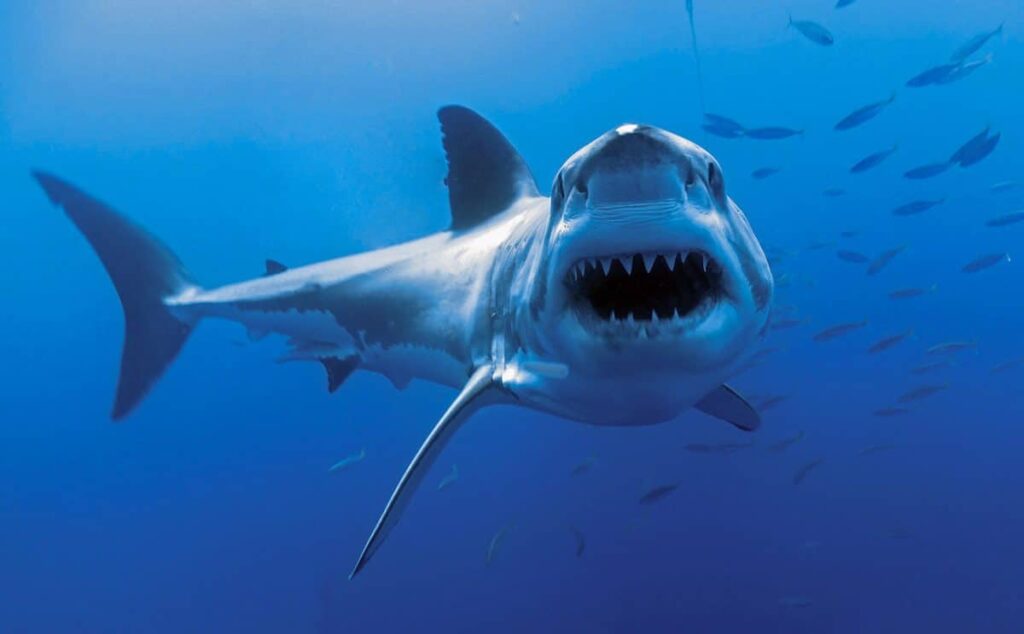Deadliest Shark Species
Sharks, the apex predators of the oceans, have long captivated our imaginations with their fearsome reputation and awe-inspiring presence. Among these magnificent creatures, certain species have earned a notorious distinction as the deadliest sharks, striking fear into the hearts of humans and dominating the narratives of marine lore. But beyond the sensationalized portrayals lies a complex truth about these enigmatic predators and their vital role in marine ecosystems.
The Great White Shark:
When discussing the deadliest shark species, it’s impossible to overlook the great white shark (Carcharodon carcharias), a formidable predator known for its imposing size, powerful jaws, and unparalleled hunting prowess. With rows of razor-sharp teeth and a keen sense of smell, the great white instills terror in the hearts of beachgoers and surfers, earning its reputation as the “king of the ocean.”
Contrary to popular belief, however, great white sharks are not mindless man-eaters but rather highly efficient hunters, primarily targeting seals, sea lions, and other marine mammals. While encounters with humans are rare, the great white’s sheer size and predatory instinct make it a formidable adversary in the oceanic realm.
The great white shark (Carcharodon carcharias) is arguably one of the most iconic and feared predators of the ocean. With its sleek, torpedo-shaped body, powerful jaws, and rows of serrated teeth, the great white commands respect as the apex predator of the marine world.
Characterized by its distinctive grayish-blue dorsal surface and white underbelly, the great white shark possesses an impressive combination of speed, strength, and agility. Adult specimens can reach lengths of up to 20 feet (6 meters) or more, with females generally larger than males. Their formidable size and predatory prowess make them dominant hunters in their marine ecosystems.
Great white sharks are found in coastal waters throughout the world’s oceans, from temperate to subtropical regions. They prefer areas with abundant prey populations, such as seals, sea lions, and smaller fish species. Using their acute senses of smell, sight, and sound, great whites are skilled hunters capable of detecting prey from great distances.
One of the most remarkable aspects of the great white shark is its feeding behavior. Using a combination of stealth and speed, these predators launch powerful ambush attacks on unsuspecting prey, often propelling themselves from the depths with astonishing force. With a bite force estimated to be over 4,000 pounds per square inch (psi), great white sharks can deliver devastating blows to their prey, inflicting mortal wounds with their razor-sharp teeth.
Despite their fearsome reputation, great white sharks are not indiscriminate killers of humans. In fact, shark attacks on humans are relatively rare and often occur due to mistaken identity or curiosity rather than predatory intent. Nevertheless, encounters with great whites can be terrifying, and their presence in coastal waters can evoke a mix of awe and trepidation among beachgoers and surfers.

The Bull Shark:
While the great white often dominates discussions of deadly sharks, the bull shark (Carcharhinus leucas) quietly earns its place among the most dangerous species. Known for its aggressive behavior, territorial nature, and ability to inhabit both saltwater and freshwater environments, the bull shark is a versatile predator capable of thriving in a wide range of habitats.
Unlike many other shark species, bull sharks are known to frequent shallow coastal waters, estuaries, and even rivers, bringing them into closer proximity to human populations. With a propensity for ambush-style attacks and a diverse diet that includes fish, turtles, and even other sharks, bull sharks command respect and caution from those who venture into their domain.
The bull shark (Carcharhinus leucas) is a formidable and adaptable predator known for its aggressive behavior and ability to thrive in a wide range of aquatic environments. With its stout body, broad snout, and powerful jaws lined with rows of sharp teeth, the bull shark commands respect as one of the ocean’s most formidable predators.
One of the most remarkable features of the bull shark is its ability to inhabit both saltwater and freshwater environments. Found in coastal waters, estuaries, rivers, and even freshwater lakes, bull sharks are highly adaptable creatures capable of tolerating a wide range of salinity levels. This adaptability allows them to venture far inland, sometimes hundreds of miles from the ocean, in search of prey.
Bull sharks are opportunistic hunters with a diverse diet that includes fish, crustaceans, mollusks, birds, and even small mammals. Their powerful jaws and strong swimming abilities make them skilled predators capable of capturing a wide range of prey, from small fish to larger marine mammals.
Despite their formidable reputation, bull sharks are not indiscriminate killers of humans. While they have been known to occasionally attack humans, particularly in areas where they overlap with human activities such as fishing, swimming, or boating, such incidents are relatively rare. Like other shark species, attacks on humans are often a case of mistaken identity or provoked by external factors rather than predatory intent.

The tiger shark:
The tiger shark (Galeocerdo cuvier) is also considered a formidable predator, with a broad diet that includes fish, seabirds, and even sea turtles. Known for its distinctive vertical stripes and blunt snout, the tiger shark possesses powerful jaws lined with serrated teeth, enabling it to tear through flesh with ease. While tiger shark attacks on humans are relatively rare, their large size and aggressive feeding behavior have earned them a reputation as one of the ocean’s most formidable predators.
The tiger shark (Galeocerdo cuvier) is a formidable predator known for its distinctive appearance, voracious appetite, and broad distribution across tropical and temperate oceans worldwide. Named for the dark, vertical stripes that adorn its body and give it a resemblance to a tiger, this apex predator commands respect as one of the ocean’s top predators.
With its robust body, blunt snout, and powerful jaws lined with serrated teeth, the tiger shark is well-equipped for hunting a wide range of prey. Its diet is incredibly diverse and includes fish, seabirds, cephalopods, marine mammals, and even other sharks. This versatility makes the tiger shark a highly successful predator capable of exploiting a variety of marine environments.
One of the most remarkable aspects of the tiger shark is its ability to scavenge and consume virtually anything it encounters. Known as “garbage cans of the sea,” tiger sharks have been found with all manner of indigestible objects in their stomachs, including license plates, tires, and even pieces of clothing. This opportunistic feeding behavior underscores the tiger shark’s adaptability and resilience in the face of changing environmental conditions.
Despite their formidable reputation, tiger sharks are not indiscriminate killers of humans. While they have been responsible for a small number of attacks on humans, such incidents are relatively rare and often occur in areas where humans and tiger sharks overlap, such as nearshore waters or areas with high fishing activity. Like other shark species, attacks on humans are typically a case of mistaken identity or provoked by external factors rather than predatory intent.

Conservation efforts aimed at protecting sharks are essential for maintaining the health and balance of marine ecosystems. These efforts include habitat conservation, regulation of fishing activities, and measures to mitigate human-shark conflicts. By better understanding and respecting these magnificent predators, we can promote coexistence and ensure the long-term survival of the shark and other species that inhabit our oceans.
One thought on “Deadliest Shark Species”
Hi there! kingwildlife.com
Did you know that it is possible to send message wholly legit and fully? We are offering a new legitimate method of sending appeals through contact forms.
It’s unlikely for messages sent via Feedback Forms to be seen as spam, as they are considered significant.
Come and sample our service without any cost!
We are able to provide up to 50,000 messages for you.
The cost of sending one million messages is $59.
This message was automatically generated.
We only use chat for communication.
Contact us.
Telegram – https://t.me/FeedbackFormEU
Skype live:contactform_18
WhatsApp – +375259112693
WhatsApp https://wa.me/+375259112693